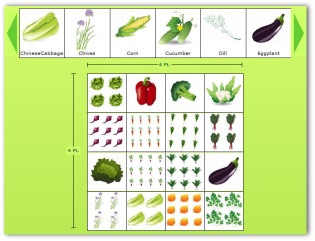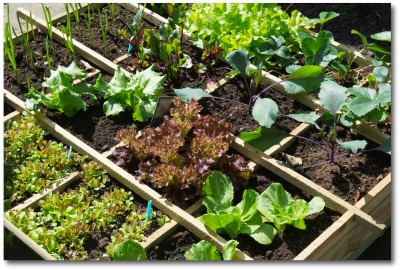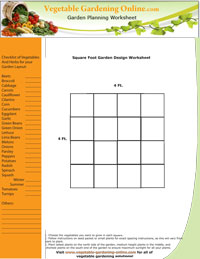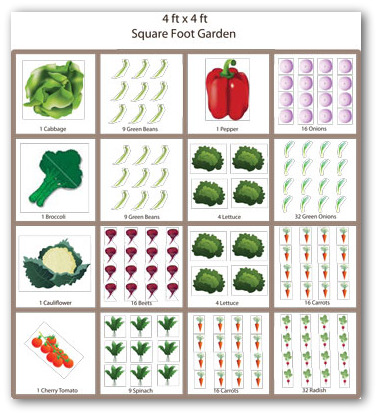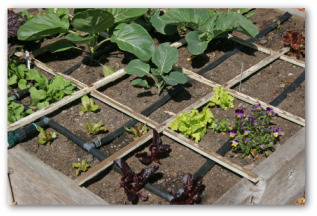Square Foot Garden Designs, Tips, and Plans
Use our free planner for designing your square-foot garden!
Easy tips and designs are provided for building and planting a simple and easy garden plan.
Just "drag and drop" the vegetables you choose for your garden plan. It's fun and easy to create your own garden design!
Whether it's a vine-ripe tomato on a sandwich or fresh lettuce straight from the garden patch to your table, the tastiest vegetables come direct from a home vegetable garden!
Square-foot gardens are a technique that many gardeners enjoy because it offers maximum yield for minimal effort.
Now this is a method we can all sink our teeth into!
If your desire is to grow your own vegetables but have hesitated in the past due to worries over the expense or aggravation being worth it, we would like to introduce you to an efficient, worry-free vegetable gardening method, which is one you should explore further.
How to Build a Square Foot Garden
* To build this type garden, you will need some 2x6 or 2x8 boards.
* Cut the boards, and nail them together to form a four foot square.
* Divide the square into 16 one-foot section, using string or small strips of board.
* Plant one kind of vegetable in each of the 16 squares.
Some medium-sized vegetables should be planted one per square.
Others, such as green beans, can be planted four per square.
Carrots and onions can be planted 9 or 12 per square.
Winter is a good time to plan your vegetable garden. A well-planned plot can produce vegetables from early summer to late fall, and beyond in some areas.
A sunny healthy growing bed of lettuce, beets, and beans gets its start with a well thought out design during the cold blustery months.
5 Tips for Garden Success!
1. Choose a sunny location for your garden.
2. Locate garden near convenient source of water.
3. Provide good fertile soil. Add a layer of mulch.
4. Follow planting instructions on seed packets.
5. Keep garden watered, and weeded!
Squarefoot Garden Designs
- Click Here for Square Foot Garden Worksheet
- Measure your garden space and plot it on graph paper implementing the square gardening scale.
- Keep taller vegetables on the north side. Sketch in the cool-season varieties.
- Calculate when those crops will mature so they can be replaced with warm-season plants.
- Combining block planting with culture techniques such as trellising or double cropping maximizes use of space.
Square Foot Gardens for Convenience
The basic layout of square gardening prevents the need for endless tilling, weeding, watering, and pest patrol.
The idea is to lay the groundwork of seed beds in separate blocks that are not over four feet wide.
A walking space is laid out around all sides of each block to prevent trampling on the garden bed while working the individual plots.
The square garden is sized just right so you can reach each plot easily when cultivating.
To divide the gardens, you can use planks to serve as walkways.
An easy way to plant the garden is to allot one squarefoot garden for each member of your family.
Test the soil for proper pH level, add amendments such as compost, fertilize, and you are ready for planting.
Any block can be fitted with a trellis or support for vining plants such as beans, cucumbers, squash, or tomatoes.
To make the most crops out of square gardening, plant different vegetables in each of the squares when possible, allowing a square foot space for each separate variety.
Square Foot Garden Plan
Download our free square gardening plan.
Or use our square foot worksheet to create your own garden plan!
Caring for a Squarefoot Garden
Proper maintenance is only a small step away with the square gardening method.
Good care consists primarily of keeping the garden bed moist, weekly feedings, and keeping the weeds out.
Repeatedly growing the same plant family in identical spots each season gives diseases a chance to build up in the soil.
After cultivating a crop from one of the following families, rotate the crops, choosing a variety from a different family.
Here are the three major vegetable families:
• Cabbage family: broccoli, cabbage, Brussels sprouts, cauliflower, rutabaga, turnip, and kohlrabi.
• Cucumber family: gourd, summer and winter squash, cucumber, watermelon, muskmelon, and pumpkin.
• Tomato family: Irish potato, pepper, tomato, and eggplant.
If you are searching for an intensive way of planting that saves 80 percent of money, time, and vegetable gardening space over conventional gardens, square foot gardening could be your best solution.
In fact, the plan produces a continuous harvest with a lot less work involved.
Other advantages include using less water because it is easier to retain soil moisture in smaller spaces, which helps conserve energy in the long run.
You Might Also like to Read:
Square Gardening